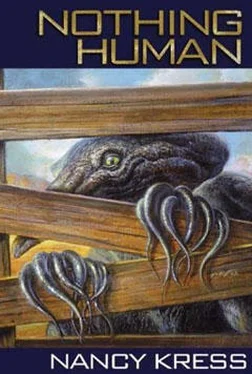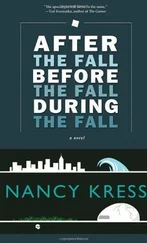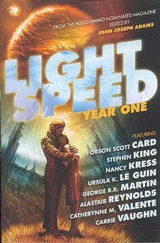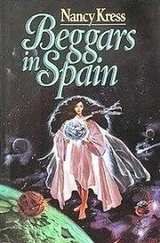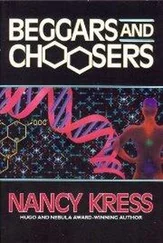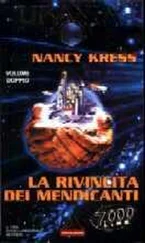Carolina put water to her lips. “Drink very small, carina.”
To please her, Lillie sipped the water. Carolina was the only person who had insisted on being present at the birth, although Lillie suspected that others waited outside to hear the outcome. Carolina had defied even Jody, unleashing torrents of Spanish and tossing her black hair defiantly until he had helplessly given up. Nothing could keep Carolina from babies, even non-human babies, or New Human babies, or whatever these three were going to be.
“Now push!” Pam commanded, and Lillie gratefully complied. She felt the equivalent of shitting a pumpkin, and gasped. “Is it… alive?”
No one answered her. “Here comes the second,” Pete said. “All right, push!”
“Is it…” She couldn’t get the rest of the words out.
“Aaaahhhhhh,” Carolina said, and Lillie fainted. A second later she was back, shocked into consciousness by some olfactory molecules from Pam, who said angrily, “Stay with us, Lillie! You’re not done!”
Like a car still good for another thousand miles, Lillie thought. These children would never see a car. “Are they…”
“Push!”
The third one finished her. She passed out, or fell asleep, but not before the unexpected came to her, startling as snow in ninety degrees. Oh, my God―
She woke all at once, undoubtedly by design. No one was in the room.
But I smelled it, Lillie thought, with complete clarity. I smelled them.
No. They, her babies, had smelled to her.
“Pam?” she called, and instantly a door melted from the wall and Pete bustled in, carrying a wrapped bundle. Lillie smelled it again.
Her child, emitting olfactory molecules as Pam and Pete did, molecules that created an image in Lillie’s mind. The image was fuzzy, mostly a smear of color, but the feeling that accompanied it was clear as spring water: distress. Too cold, too bright, not the womb. Her child, like all children, was protesting the birth experience.
Pete didn’t ask how Lillie felt. “Do you want to see her?”
“Yes,” Lillie said, and struggled to sit up.
Pete put the bundle on Lillie’s lap and unwrapped it. Lillie gasped. She’d been told, but still… Pete didn’t notice the gasp. He glowed with the satisfaction of the right way.
Pete said importantly, “The torso is tilted forward like that to relieve pressure on the vertebrae, and then the neck has that pronounced curve to counteract the tilt, so the adult form will still be able to face forward. The legs are so short in order to keep the center of gravity lower. Those short legs will be very strong. The knee bends backward like that to prevent the grinding and deterioration that you humans all get eventually. Including you, Lillie. This human will live about one hundred and sixty years, and we built everything to last. The bigger ears, of course, are better at gathering sound. We thought about eliminating the vocal chords, since essentially they’re unnecessary, but in the end—”
“Be quiet,” Lillie said.
Pete, unlike Pam, occasionally listened. He fell silent while Lillie studied the sleeping… baby.
A cross between a troll and a turtle, with the curved neck of a swan.
The baby’s skin was thick, gray-green, scaly. Its body, with all the features Pete had so clinically described, reminded Lillie of an illustration in a picture book she’d had as a child, a drawing of a stunted gnome. On the child’s back, however, was a very thin, flexible, hard shell, extending from tailbone to neck. The feet were webbed with more of the gray-green turtle skin. The hands had scaled skin, too, but ended in a mass of long, delicate tentacles.
Most awful was the face. The nose was a long snout. There was no mouth. Two eyes closed in sleep.
Pam bustled in. “Isn’t that a good engineering job, Lillie? She can survive in sand, dust, rain, heat, go into estivation in the cold. And―”
“How does she eat?” Lillie faltered, and a part of her brain not in shock was amazed that she got the words out at all.
“That’s the best part,” Pam said triumphantly. “We saved it as a surprise. There’s a slit just under the curve of the throat for conventional feeding; you can’t see it now because it seals completely when not used. But in an emergency, she can also send a tubule into the earth for water and nitrates and then synthesize ATP for energy from sunlight. It’s a limited function, only supplementary, of course, but an ingenious one. What Pete and I did was use halobacteria, which photosynthesizes not with chlorophyll but with retinal rhodopsin, and—”
Lillie scarcely listened. It didn’t stop Pam, who went on about halobacteria and photosynthesis before returning to her tour of Lillie’s child.
“That long nose allows for filters that should block nearly all pathogens before they get inside, but in case not, she’s got an immune system like you wouldn’t believe. She can also draw her entire body under that shell against really adverse conditions and just estivate for up to six months. Her—”
“How does she talk?” Lillie stared at the mouthless face.
“Why are you so interested in that?” Pam said, offended. “We almost didn’t give her your primitive communication system, since she has ours. But if she wants to, she can tilt her head back slightly and talk through her throatslit. The vocal chords are intact, as Pete told you. And of course, her hearing is excellent and she can hear your speech just fine.”
“Will she understand… is she…”
“She’s a lot more intelligent than you are,” Pam said. “Really, Lillie, don’t you think I know my profession?”
Lillie unwrapped the baby’s diaper. The baby had normal genitalia. Against the rest of her, the sight was terrible.
“Couldn’t do much about that,” Pete sighed. “The design has to stay cross-fertile with the old-style humans as long as they’re still around. Although maybe we can fix that next time through here.”
Lillie started to tremble. She was not this strong. She’d thought she was, but she made a terrible mistake, she couldn’t do this, it wasn’t possible, this thing was not human, oh God help me Uncle Keith ―
The baby opened her eyes.
“There!” Pam said in triumph. “Our other surprise for you!”
Under a thick nicitating membrane, the baby’s irises and pupils were a duplicate of Cord’s, of Lillie’s own. Deep gray flecked with gold, alert and bright. Human eyes. A smell came to Lillie, an image in the mind, a stirring in the heart. The baby looked at her.
Immediately, Lillie loved her fiercely.
A trick of the olfactory molecules.
So what? This was Lillie’s child.
Pam said, “Do you want to see the other two? Bring them in, Pete. Lillie, what are you going to name them? Lillie?”
Lillie didn’t answer. She gazed back at the baby, lost in the infant’s eyes, its helpless need of her. She would do anything to protect this child. Anything.
And oh God, the baby was so beautiful.
Rafe said, “It’s a defense, isn’t it. Built in. Like a skunk’s bad smell.”
“Not the best comparison,” Lillie said acidly. They sat on chairs outside Scott’s lab, in the early evening. To the west the sun was setting amid piles of gold and orange clouds. Lillie’s infants were inside, being poked at by Scott, with Sajelle and Carolina in eager attendance.
Rafe continued, “When any of us are near the babies, we love them because they continuously send out pheromones to make us love them. It’s only when we’re out of that particular olfactory range that we remember what they really are.”
“When did you become a biologist, Rafe? You’re supposed to be our engineer.” Their engineer. Lillie was leaving with her children in another two weeks. Jody had found her an abandoned vacation house at the foot of the El Capitan mountains, north of what had once been the city of Ruidoso. The place had, he said, a good water supply, insulation, stored canned food, fertile soil. She wondered if Jody had had to bury the bodies of its previous owners, and what bioweapon they had died of.
Читать дальше
